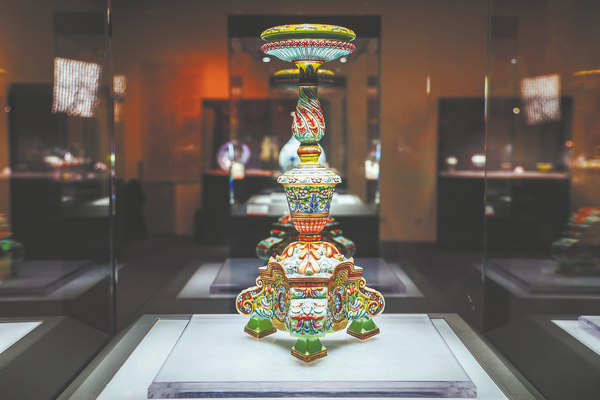
A ceramic candle holder with relief floral and dragon patterns from the Yongzheng period of the Qing Dynasty (1644-1911). It incorporates the Baroque style. CHINA DAILY
Qing Dynasty ruler played a vital role in artistic excellence by subtly refining production and style, and integrating Western painting techniques, now celebrated in an exhibition in Beijing, Lin Qi reports.
Years ago, the buzzword term "Yongzheng so busy" was invented to echo a pop culture moment in which Emperor Yongzheng of the Qing Dynasty (1644-1911) appeared as the main hero in several period dramas that tell of political battles tinged with love triangles.
The real emperor is indeed viewed as an industrious monarch whose work played a vital role in the successive stability and prosperity which began with the reign of his father Emperor Kangxi, and that continued through his son Qianlong's rule.
Yongzheng's dedication to excellence was exemplified in governance and his patronage of art and aesthetic pursuits he is still known for today. The variety of artworks, particularly ceramics in a range of hues, that decorated his living spaces reflect his aesthetic preferences — delicate and elegant — as the emperor approved, in person, the dimensions, colors and patterns.
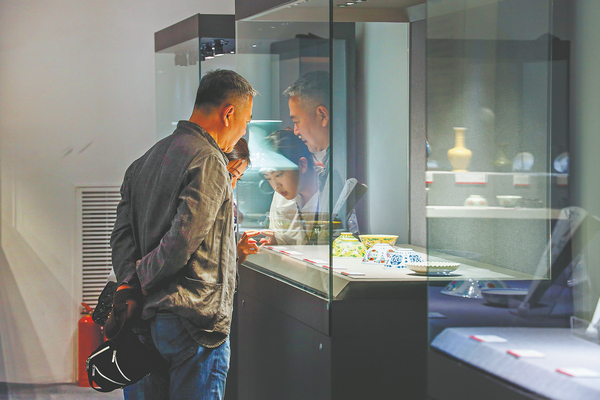
Actualize the Perfect Clarity, Achieving Centrality and Harmony, an ongoing exhibition dedicated to Yongzheng's culturally rich life, which also reveals his temperament, as well as his emphasis on art to exact imperial supremacy, is at the Poly Art Museum in Beijing. CHINA DAILY
The fine ceramics reveal the subtle refinement that Yongzheng favored — from monochromatic to doucai (contrasted colors) and qinghua (cobalt blue and white) — and are among over 100 works of art at the ongoing exhibition Actualize the Perfect Clarity, Achieving Centrality and Harmony. The objects reveal his temperament and his emphasis that art should be made to exact imperial supremacy and authority.
The exhibition runs until May 26 at the Poly Art Museum in Beijing.
An impressive plate, 50 centimeters in diameter, is highlighted in the exhibition as a testimony to the technical brilliance of fencai, or famille rose ware, during Yongzheng's reign. Objects made in this style assume rosy opaque colors above glaze to deliver understated beauty.
"Its elegance immediately catches your attention," says Li Jiawei, one of the exhibition's curators.
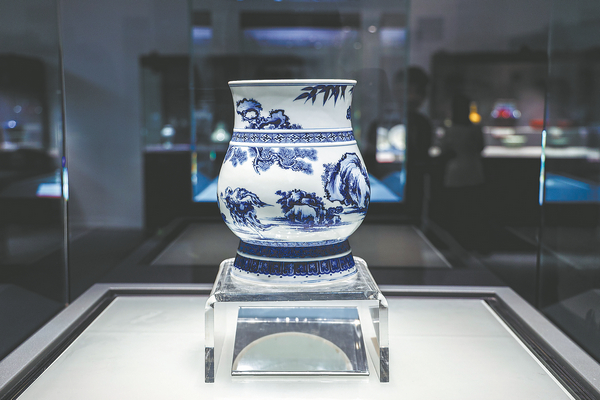
A cobalt blue and white qinghua vessel. CHINA DAILY
Eight peaches and five bats are dispersed throughout the plate's inner and outer sides. The peach symbolizes vigor and prosperity, while the bat implies auspiciousness in Chinese folk tradition. The second half of bat's Mandarin pronunciation, as fu from bian fu, is the same as that of fortune and bliss.
"A closer look at the peaches shows the smooth transition from rosy hues to light green, indicating the integration of Western painting skills. The leaves have varied degrees of green, giving the audience a feel of the fruit's ripeness," Li adds.
"The inner motifs merge with the outer ones. The branches and leaves connect the inner and outer parts into a perfect whole, which exhibits the artistic height of Yongzheng porcelain."
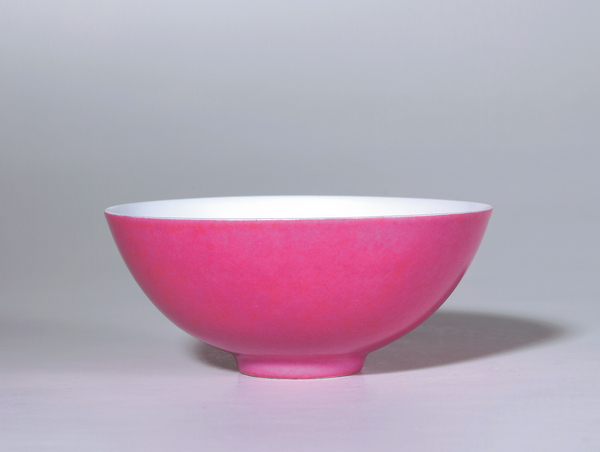
A rosy bowl for tea. The rosy glaze is called yanzhi hong (blush pink), showing Yongzheng's favor of an elegant style. CHINA DAILY
Just as he embraced a reformative policymaking spirit, Yongzheng pushed to upgrade ceramic surfaces. He ordered artisans at imperial ateliers to model or employ styles from previous dynasties, such as those of the Five Kilns of the Song Dynasty (960-1279), with new colors and glazing techniques.
Yongzheng ushered in a trend to incorporate Western techniques in ceramic design. Jin Liyan, a ceramics connoisseur, says that historic documents mention that the imperial kilns in Jingdezhen, Jiangxi province, produced different styles of wares that employed Western styles. Examples of this are displayed in the exhibition, including a ceramic candle holder with relief floral and dragon patterns.
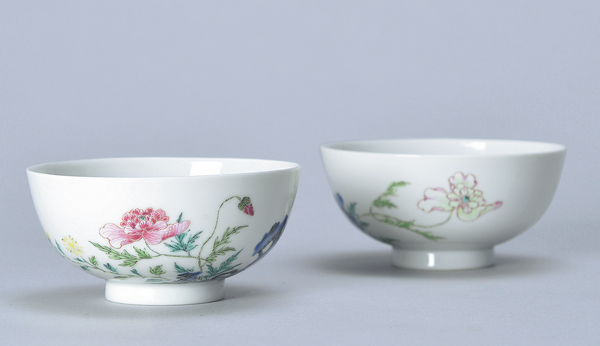
A pair of small bowls featuring corn poppy flowers. CHINA DAILY
The object was glazed with yangcai (foreign enamels), an important technical innovation that marks the full bloom of ceramics during Yongzheng's reign. Its complicated structure, elaborate patterns and rich colors show the influence of European styles, such as Baroque art.
"The exhibition is a celebration of the grace embodied in ceramics made during Yongzheng's 13-year reign," Jin notes, "including those under the supervision of Tang Ying, a ceramic artist of repute who was committed to creating new colors, techniques, and styles for the emperor's atelier."
Yongzheng personally supervised the design of the wares to adorn palaces, evidenced by royal documents in which he gave instructions such as "the patterns must be more refined".
The emperor's artistic creativity was realized by the works of gifted ceramists such as Tang and Nian Xiyao, who oversaw ceramic making at imperial kilns.
 Editor:Qiu Xiaochen
Editor:Qiu Xiaochen